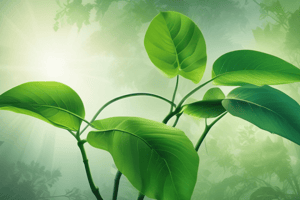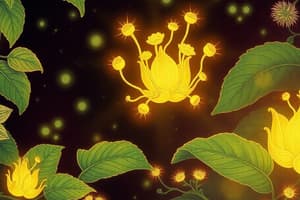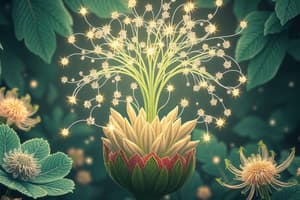Podcast
Questions and Answers
What is the primary role of chlorophyll in the process of photosynthesis?
What is the primary role of chlorophyll in the process of photosynthesis?
- To transport water from the roots to the leaves
- To absorb light energy and convert it into chemical energy (correct)
- To produce oxygen as a byproduct
- To facilitate gas exchange through stomata
Which of the following is NOT a requirement for photosynthesis to occur?
Which of the following is NOT a requirement for photosynthesis to occur?
- Light energy
- Carbon dioxide
- Water
- Oxygen (correct)
What is the equation for photosynthesis?
What is the equation for photosynthesis?
- Light energy + CO₂ + H₂O → C₆H₁₂O₆ (glucose) + O₂ (oxygen) (correct)
- Light energy + CO₂ + O₂ → C₆H₁₂O₆ (glucose) + H₂O
- Light energy + CO₂ → C₆H₁₂O₆ (glucose) + O₂ (oxygen)
- Light energy + H₂O + O₂ → C₆H₁₂O₆ (glucose) + CO₂
What happens to excess glucose produced during photosynthesis?
What happens to excess glucose produced during photosynthesis?
Why do plants stop making food at night when it is dark?
Why do plants stop making food at night when it is dark?
What is the primary reason for the presence of starch in the part of the leaf exposed to light?
What is the primary reason for the presence of starch in the part of the leaf exposed to light?
What is the most likely reason why the rate of photosynthesis would decrease in an experiment using a water plant and a lamp?
What is the most likely reason why the rate of photosynthesis would decrease in an experiment using a water plant and a lamp?
Which of the following is not a requirement for photosynthesis?
Which of the following is not a requirement for photosynthesis?
What is the role of stomata in the process of photosynthesis?
What is the role of stomata in the process of photosynthesis?
What is the equation for photosynthesis?
What is the equation for photosynthesis?
Plants release carbon dioxide as a byproduct of photosynthesis.
Plants release carbon dioxide as a byproduct of photosynthesis.
Chlorophyll is the green substance in plants that traps light energy.
Chlorophyll is the green substance in plants that traps light energy.
Stomata are primarily responsible for the transport of water within the plant.
Stomata are primarily responsible for the transport of water within the plant.
Animals and plants both obtain their energy directly from the food they eat.
Animals and plants both obtain their energy directly from the food they eat.
Photosynthesis only occurs during the day when there is light.
Photosynthesis only occurs during the day when there is light.
What are the tiny openings on leaves called?
What are the tiny openings on leaves called?
What is the equation for photosynthesis?
What is the equation for photosynthesis?
Where is excess glucose stored in plants?
Where is excess glucose stored in plants?
Explain the role of stomata in photosynthesis.
Explain the role of stomata in photosynthesis.
How is water transported to the leaves of the plant?
How is water transported to the leaves of the plant?
Flashcards are hidden until you start studying
Study Notes
Photosynthesis
Key Concepts
- Photosynthesis is the process by which plants make food using light, water, and carbon dioxide, producing sugar (glucose) and oxygen.
- Chlorophyll is a green substance in plants that traps light energy.
- Stomata are tiny openings on leaves for gas exchange (carbon dioxide in, oxygen out).
Process Overview
- Light energy is absorbed by chlorophyll in the leaves.
- Carbon dioxide enters through stomata, while water is absorbed by roots and transported to the leaves.
- Light energy is used to convert CO₂ and H₂O into glucose and O₂.
- Excess glucose is converted to starch and stored in roots, stems, and seeds (e.g., potatoes, rice, corn).
Requirements
- Light energy is required for photosynthesis.
- Carbon dioxide is obtained from the air through stomata.
- Water is absorbed by roots and transported to the leaves.
Equation for Photosynthesis
- Light energy + CO₂ + H₂O → C₆H₁₂O₆ (glucose) + O₂ (oxygen)
Studying That Suits You
Use AI to generate personalized quizzes and flashcards to suit your learning preferences.





